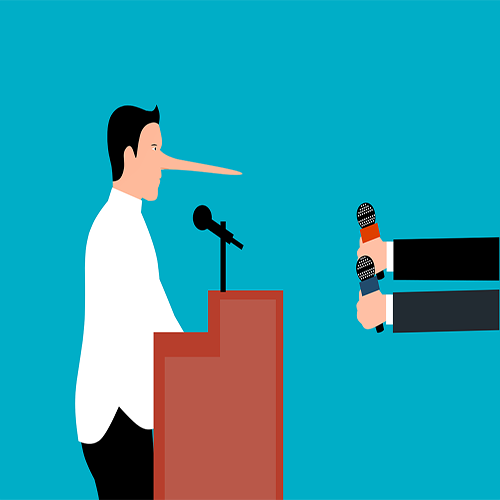They say honesty is the best policy, but honestly, how many people is that true of?
Sadly, we live in a world that leaves us surrounded by deception and lies. Lying is common in all our relationships. People are inherently selfish and will often lie or stretch the truth to protect themselves. The good news is though, that most liars aren’t very good at it! We’ve compiled a list of nine little gestures people make when they aren’t telling the truth so that you are equipped to tell when someone is lying.
Make sure to read until the end because the last one is the biggest giveaway. Let’s start with body language.
Number 1: The hands.
Liars often use gestures with their hands after they speak, as opposed to during or before a conversation like most people would when they’re telling the truth. This is because the brain is doing too many things when making up a story to gesture like they normally would. When trying to tell a lie, the human brain has to try and balance little bits of truth, and ensure that the story coheres and is bulletproof.
A study done in 2015 by a university in Michigan looked at 120 media clips of high-stakes court cases as they tried to understand how people behave whilst lying as opposed to when they are telling the truth. It found that those who lie are more likely to gesture with both of their hands. In 40% of the lying clips, people gestured with both hands. This was only true for 25% of people telling the truth.
Admittedly, this isn’t a massive difference, but it’s worth keeping an eye out for! When someone is being dishonest, for whatever reason, they might have a tendency to face the palms of their hands away from you. They might also put them in their pockets or hide them under the table. Certainly, it is important to always look for the hands when trying to decipher whether the story someone is telling you is truthful.
Number 2: Looking uncomfortable.
Scratching and fidgeting whilst telling a story or answering a question is a common sign that someone is lying. This can extend to body movements like rocking back and forth or cocking the head to one side and shuffling one’s feet. All of these subtle but significant movements can point to deception. The cause for much of this is fluctuations in the autonomic nervous system.
When someone is lying, for the most part, they feel nervous. This nervousness triggers people to feel itches or tingles in their bodies, which leads to scratching and fidgeting.
Number 3: Grooming behaviors.
Often when lying people will twirl their hair or straighten their clothes. These signs of grooming behaviors stem from a need to find control. When making up a story, people are likely to feel out of sorts, so readjusting themselves is a way to solve this. Keep an eye out for small movements that seek control, or otherwise are because someone is unaware of what they are doing.
Number 4: The eyes.
Someone telling a lie is extremely likely to look away or break your gaze at a crucial moment. They say the eyes are the window to the soul, but they might actually be a window to the truth. People are likely to look away partly out of guilt, partly out of fear that their lie will be detected, and partly because they are trying to think of what to say next. The opposite can also be true, however.
The same study we talked about earlier found that 70% of clips of people lying showed them staring directly at the people they were lying to. We might be able to attribute this to an overcompensation when not telling the truth. Of course, staring and looking away are two opposites so it is hard to know which one to look for, but the general rule would be that any sort of dramatic eye movements might signal a lie.
Someone who is telling the truth would not need to compensate for their eye movements at all, so staring or breaking eye contact, while opposites, both signal the same thing. You might have heard when you were younger that people always look to the left when telling a lie, but this is a myth that should be debunked. Everyone has a tell, but not everyone tells is the same. Liars could look in any direction!
Number 5: The mouth.
A person who is lying might have the impulse to fold or roll their lips back so that they almost vanish. This is essentially them trying to hold back emotions or facts, which is obviously necessary when telling a lie. Look for pursed lips too, as this usually means that someone does not want to engage in the conversation.
Number 6: Complexion.
You’re probably familiar with the phrase “you’ve gone as white as a sheet”, and this is a phrase that can absolutely be applied to someone who is being untruthful. The phenomenon happens when the blood leaves a person’s face, and though the reason this happens when lying is unclear, it definitely happens. This is a good sign to look out for because although it is involuntary like the others, it cannot be stopped.
A good liar, if there is such a thing, might know to relax their eyes and avoid itching and fidgeting. However, if they are nervous or scared, they will not be able to do anything about their complexion.
Number 7: Sweating or dryness.
Once again, these are two opposites, but they are still changed from the norm and therefore can be used to spot a liar. The autonomic nervous system changes can trigger liars to regulate their bodies differently. Sweating in the upper lip, forehead, chin, and around the mouth are all things to look out for.
At the same time, if someone has dryness around their eyes or mouth, they might blink a lot or squint, and maybe also lick or bite their lips to compensate for this. Be sure to check for all of these small tells if you think someone is not telling you the truth.
Number 8: The voice.
Someone’s voice changing from normal to high-pitched is a common reaction to nerves. This is because when we are nervous our vocal cords have a tendency to tighten up in response to the stress we are feeling. A break in someone’s voice or a need to clear their throat also are signs of this and mean they are coping with the discomfort of tightened muscles. All of these things signal dishonesty.
What also signals dishonesty could be a change in the volume of their voice. Think about Austin Powers when he comes out of being frozen and then halves that and that’s what we’re talking about! People often get louder when they are getting defensive, and someone who is telling the truth has no need to get defensive.
Number 9: Overcompensating in their speech.
This sounds complicated but it is more obvious than you might think. Here we are referring to things someone might say to convince you they are telling the truth. Phrases like “I want to be honest with you” or “I’ll tell you the truth” or any variations of those are actually signs they might be lying. Of course, someone might also say this if they actually are telling the truth, but what is worth remembering is that someone telling the truth doesn’t need to convince you that that’s what they are doing. A liar does.
Another change in their speech might be “thinking” words, such as “um”, “er” and “like.” Remember again, someone who is telling a true story does not need to think about it much, they would simply be reliving what happened and for the most part, this is a pretty simple task. If there are pauses in their speech, and the words they are using to fill these gaps, that is likely a sign of a lie. People tend to use these words when attempting to buy time in order to figure out what to say next. Another thing to look for is general slip-ups. If you’re familiar with a Freudian slip, which is when you say something unintentionally because your subconscious is willing to come out, that’s sort of what we’re talking about here.
The bottom line here is, most people are bad liars. Telling a lie is uncomfortable and takes a lot more thought than telling the truth. As a result of this, the chances are that the truth will slip out at some stage and the liar will have to correct themselves. It sounds obvious, but look for inconsistencies in the story, and try to identify the panic when someone tries to correct them and pull their web of lies back together again.
Sharing Is Caring!






